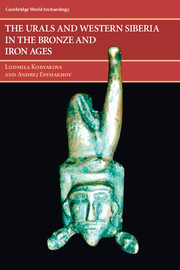Book contents
- Frontmatter
- Contents
- List of Plates, Figures, and Tables
- Foreword, by Philip L. Kohl
- Preface
- Introduction
- PART ONE THE BRONZE AGE: THE RISE OF ECONOMIC AND CULTURAL COMPLEXITY
- PART TWO THE IRON AGE – FORMING EURASIAN INTERACTIONS
- 5 The Transition to the Iron Age and New Tendencies in Economic Development
- 6 The Southern Urals within the Nomadic World: at the Cultural Crossroads
- 7 The World of Cultures of Cis-Urals Forest Zone of Eastern Europe: the Maintenance of Cultural Identities
- 8 The Forest-Steppe Cultures of the Urals and Western Siberia: on the Northern Periphery of the Nomadic World
- 9 Social Trends in North-Central Eurasia During the Second and First Millennia bc
- Notes
- References
- Index
8 - The Forest-Steppe Cultures of the Urals and Western Siberia: on the Northern Periphery of the Nomadic World
from PART TWO - THE IRON AGE – FORMING EURASIAN INTERACTIONS
Published online by Cambridge University Press: 03 February 2010
- Frontmatter
- Contents
- List of Plates, Figures, and Tables
- Foreword, by Philip L. Kohl
- Preface
- Introduction
- PART ONE THE BRONZE AGE: THE RISE OF ECONOMIC AND CULTURAL COMPLEXITY
- PART TWO THE IRON AGE – FORMING EURASIAN INTERACTIONS
- 5 The Transition to the Iron Age and New Tendencies in Economic Development
- 6 The Southern Urals within the Nomadic World: at the Cultural Crossroads
- 7 The World of Cultures of Cis-Urals Forest Zone of Eastern Europe: the Maintenance of Cultural Identities
- 8 The Forest-Steppe Cultures of the Urals and Western Siberia: on the Northern Periphery of the Nomadic World
- 9 Social Trends in North-Central Eurasia During the Second and First Millennia bc
- Notes
- References
- Index
Summary
CULTURAL GROUPS OF THE FOREST-MOUNTAIN AREA OF THE MIDDLE AND SOUTHERN URALS
When we discussed the Urals metallurgy earlier in this book, we referred in particular to the Itkul culture, which is the basis of the Trans-Uralian metallurgical center of the Iron Age. Now we will discuss this in more detail, as well as look at other groups of the forest-mountain area of the Urals known by the name of Gamayun. These cultural formations are not so large compared with those we have discussed earlier, but they represent a rather interesting example of coexistence in the same environment, adapting to it in different ways and with different economic strategies.
The territory occupied by sites of the Itkul and Gamayun cultures extends in a narrow band (about 150 km wide) along the eastern slope of the Ural Mountains from the Vagil, Tura, and Rezh rivers in the north to Chelyabinsk city in the south (Fig. 8.1). The local environments include the dendritical system of fresh water mountain lakes and rivers of the Ob' River basin, a continental climate favorable for hunting and fishing, and containing unlimited forest and mineral resources.
Both cultures are dated to the period between the eighth and third centuries bc, with some differences in internal chronology (Bel'tikova 1993; Borzunov 1992). Both of them lack archaeological burials with a few exceptions in the Itkul culture.
- Type
- Chapter
- Information
- The Urals and Western Siberia in the Bronze and Iron Ages , pp. 277 - 315Publisher: Cambridge University PressPrint publication year: 2007



